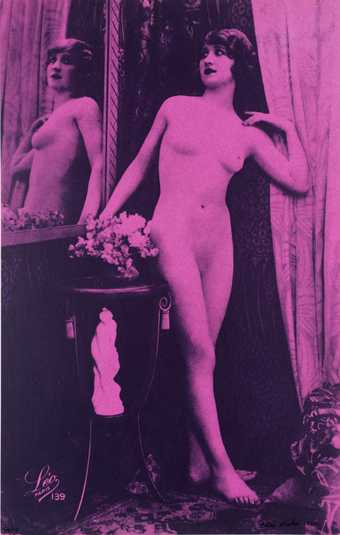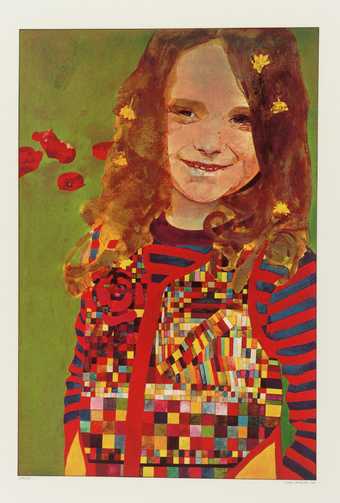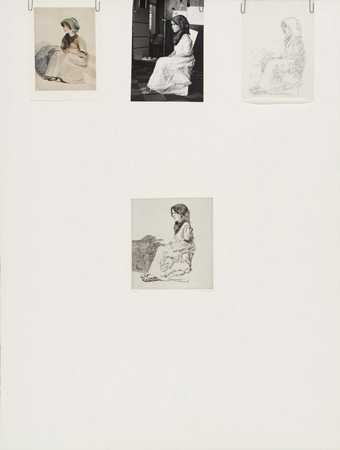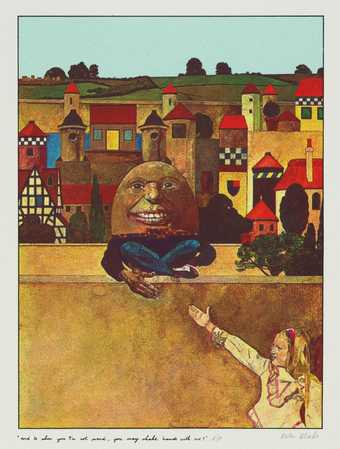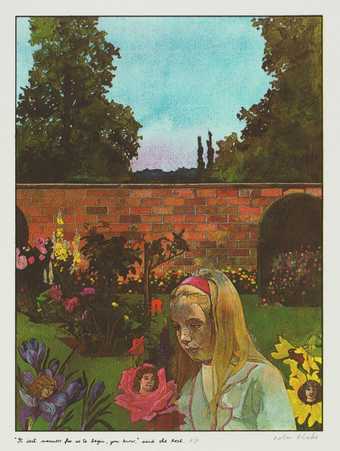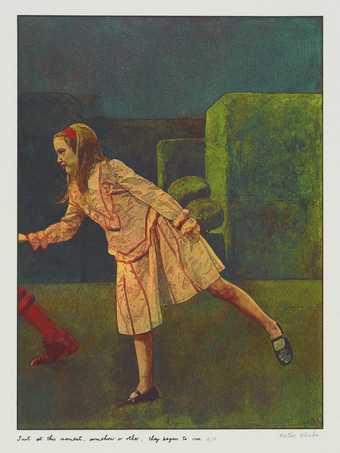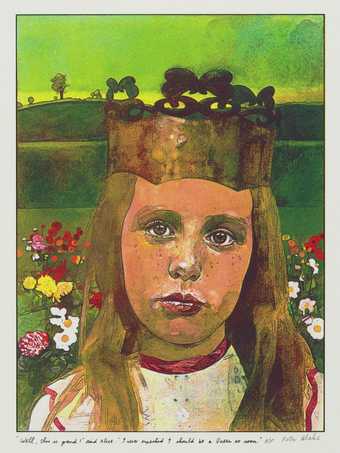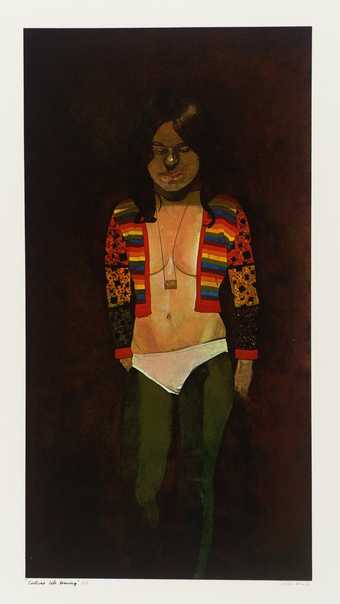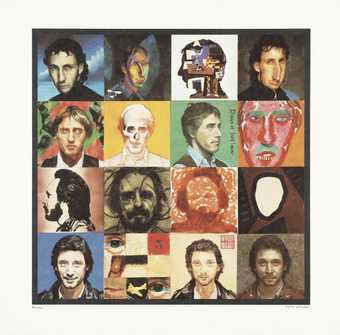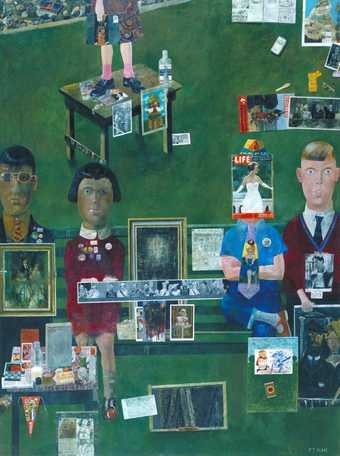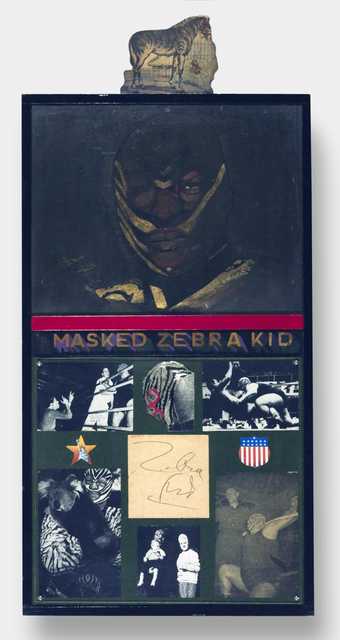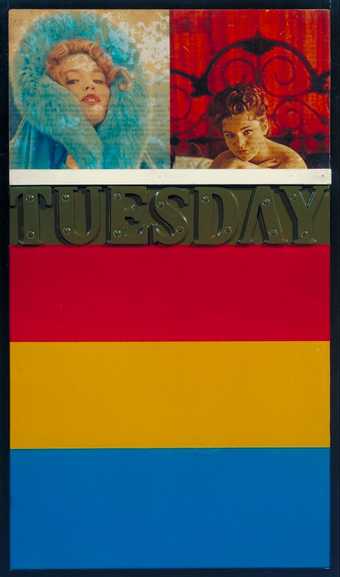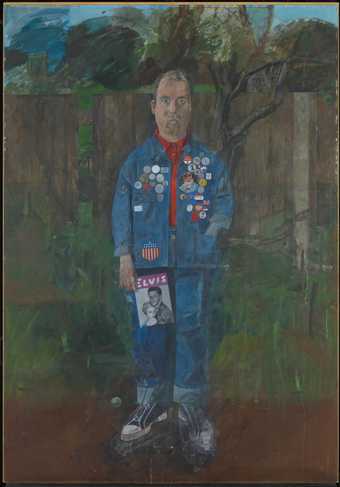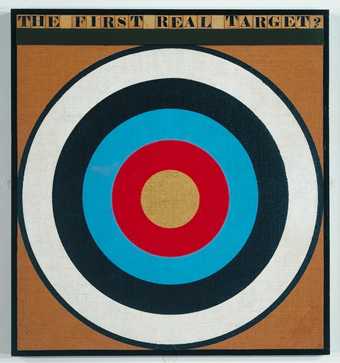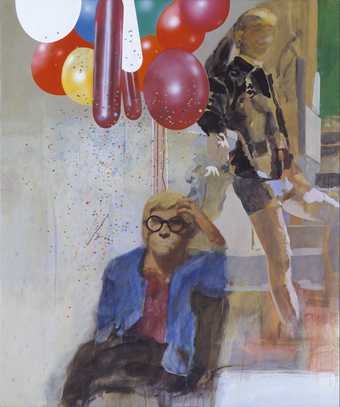
Not on display
- Artist
- Peter Blake born 1932
- Medium
- Oil paint on canvas
- Dimensions
- Support: 992 × 1244 mm
- Collection
- Tate
- Acquisition
- Presented by the Friends of the Tate Gallery out of funds bequeathed by Miss Helen Arbuthnot 1983
- Reference
- T03790
Display caption
Gallery label, September 2004
Does this text contain inaccurate information or language that you feel we should improve or change? We would like to hear from you.
Catalogue entry
T03790 ‘THE MEETING’ OR ‘ HAVE A NICE DAY, MR HOCKNEY’ 1981–3
Oil on canvas 39 × 49 (992 × 1244)
Not inscribed
Presented by the Friends of the Tate Gallery (purchased out of funds bequeathed by Miss Helen Arbuthnot) 1983
Prov:
Purchased from Waddington Galleries, by the Friends of the Tate Gallery
Exh: Peter Blake, Tate Gallery, February–March 1983 (105, repr., also repr. in earlier state, p.2 of loose supplement inserted in catalogue); Peter Blake, Kestner Gesellschaft, Hannover, April–June 1983 (cat. 80, repr. in col. in earlier state); The Hard-Won Image, Tate Gallery, July–September 1984 (25, repr.); Forty Years of Modern Art, Tate Gallery, February–April 1986 (works not listed)
Lit: Carl Haenlein, ‘Über Peter Blake und Pop Art’, Peter Blake exhibition catalogue, Kestner Gesellschaft, Hannover, 1983, pp.9, 16, repr. in col p.17; The Tate Gallery Illustrated Biennial Report 1982–84, 1984, p.63, repr. in col.; Marina Vaizey, Peter Blake, 1986, p.40, pl.31
This painting records a visit made by the artist and Howard Hodgkin to David Hockney in Venice, California, in 1979. At the end of this trip Peter Blake and Howard Hodgkin each decided to commemorate their journey with a series of three ‘souvenir’ works to be painted on their return to England. Blake's companion pieces to this painting are ‘A Remembered Moment in Venice, Cal’ and ‘Montgomery Clift was a Twin’. Both works were exhibited at Peter Blake's retrospective exhibition at the Tate Gallery, 1983, as ‘works in progress’ (cat.2 and 5, of supplement to exhibition, both repr.). The artist still hopes to exhibit these alongside Howard Hodgkin's works as a completed project. The works by Hodgkin are ‘David's Swimming Pool’ 1982, 24 1/2 × 31 1/4" (62.2 × 31.2), mixed media on paper; ‘David Hockney in Hollywood’ 1982, 42 1/2 × 51 1/2" (108 × 130.8); ‘Déjà Vous’ 1982, 35 × 51" (88.9 × 129.5) (they all belong to the artist).
Peter Blake has based the Tate's painting on Courbet's ‘The Meeting’ or ‘Bonjour Monsieur Courbet’ 1854 (Musée Fabre, Montpellier). The two visiting painters in Blake's work take the place of Monsieur Bruyas (Blake) and his manservant (Hodgkin) in the original, as they greet Courbet (Hockney). Each painting is a documentary account of an event in its artist's life. In the Courbet the artist has just been left at the roadside, and the carriage which brought him on this first visit to his patron, near Montpellier, can be seen disappearing into the distance. Blake refers to this by imitating the horse and carriage in graffiti on the back wall of his painting (between the two tree trunks on the right). Courbet places a dog in the centre of his painting as does Blake, although Blake bases his foxhound on a painting by Stubbs in the Tate (‘A Hound and a Bitch in a Landscape’ (1792), T01705, oil on canvas, 40 × 50" (101.6 × 127)).
If Blake had continued with the painting he would have included more people involved in what he sees as the self obsessiveness of making themselves more ‘beautiful’, with body builders and joggers jostling in the confined space and California sun. The figure of his daughter Liberty is seen skating off to the right - a manifestation of healthy living. Blake intended originally to place her between the figures of himself and Hockney, literally weaving in and out of the three static ‘and rather dowdy Englishmen’. Their incongruity is further emphasised by the typically English dog, after Stubbs.
Blake used photographs of skaters taken in Battersea Park as reference for the figures in his painting. There are no working drawings, only preliminary sketches and notes. Photographs were also taken for the three central characters and they helped Blake to establish poses consistent with those in Courbet's painting. When asked to stand as the figure for Courbet, Hockney could not find a pole similar to the staff in the original painting; he did however have to hand the large brush depicted (which had been used in advertising a paint brush company). Blake used this impromptu joke in the final painting.
Blake is fascinated by the inconsistent fall of shadows in Courbet's work and intended to emulate this feature in his own painting. However only Hodgkin's and his own shadows are completed. Courbet's painting was influenced by a popular print of the period, ‘The Wandering Jew’, and Courbet placed himself in the position of the Jew to suggest his isolation on this visit to the countryside. In similarly portraying Hockney in this ‘isolated’ position, Blake intended to emphasise his detachment from England.
For this series of works Blake chose three similar frames which are intended to echo the heavy gilded frames of the nineteenth century Salons. In this way Blake both recalls Courbet by using his type of frame and provides a distinct contrast to the wide painted frames in the works of Howard Hodgkin, to which Blake's own in this series are expected to be hung in close proximity. The frame on the Tate's picture was bought by Peter Blake from a local junk shop, and is meant to be exhibited in its damaged state. It is an instance of Blake's interest in ‘found objects’ and his affection for objects with past associations. The frame therefore plays a specific role in the overall understanding of this painting.
The entry is based on a conversation with the artist on 2 May 1986, and is approved by him.
Published in:
The Tate Gallery 1982-84: Illustrated Catalogue of Acquisitions, London 1986
Explore
- architecture(30,960)
-
- garden structures(1,939)
-
- park(320)
- townscapes / man-made features(21,603)
-
- building - non-specific(3,161)
- path(385)
- signage(467)
- wall(626)
- universal concepts(6,387)
-
- humour(1,441)
- recreational activities(2,836)
- clothing and personal items(5,879)
-
- cane / walking stick(118)
- hat(1,437)
- hat, cap(336)
- staff(108)
- paintbrush(90)
- actions: expressive(2,622)
-
- greeting(89)
- crouching(276)
- group(4,227)
- Blake, Liberty(1)
- Blake, Peter(2)
- Hockney, David(9)
- Hodgkin, Howard, Sir(1)
- Stubbs, George(5)
- groups(310)
- individuals: female(1,698)
- individuals: male(1,841)
- self-portraits(888)
- cities, towns, villages (non-UK)(13,323)
-
- Venice Beach(1)
- USA, California(112)
- lifestyle and culture(10,247)
-
- advertising(536)
- cultural identity(7,943)
- friendship(1,628)
- arts and entertainment(7,210)
-
- artist, painter(2,545)
You might like
-
Peter Blake Leo 139
1969 -
Peter Blake Girl in a Poppy Field
1974 -
Peter Blake Liberty as a ‘Suffolk Child by John Constable R.A.’
1976 -
Peter Blake ‘and to show you I’m not proud, you may shake hands with me!’
1970 -
Peter Blake ‘It isn’t manners for us to begin, you know’, said the Rose
1970 -
Peter Blake Just at this moment, somehow or other, they began to run
1970 -
Peter Blake ‘Well, this is grand!’ said Alice
1970 -
Peter Blake Costume Life Drawing
1971 -
Peter Blake Illustration to the cover of ‘Face Dances’
1981 -
Peter Blake On the Balcony
1955–7 -
Peter Blake The Masked Zebra Kid
1965 -
Peter Blake Tuesday
1961 -
Peter Blake Self-Portrait with Badges
1961 -
Peter Blake The First Real Target
1961 -
Peter Blake Portrait of David Hockney in a Hollywood Spanish Interior
1965

